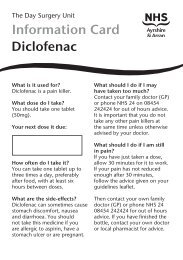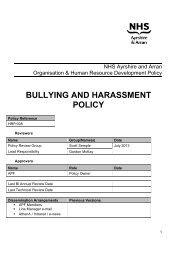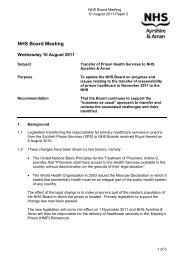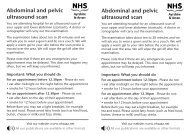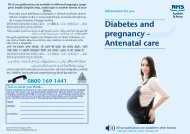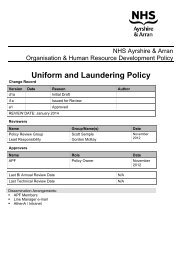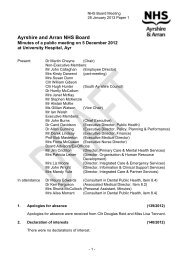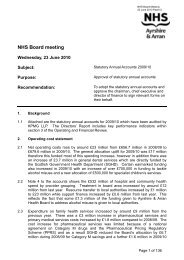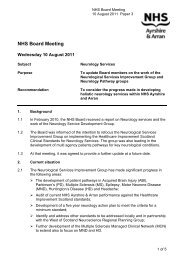The Management of Significant Adverse Events in NHS
The Management of Significant Adverse Events in NHS
The Management of Significant Adverse Events in NHS
Create successful ePaper yourself
Turn your PDF publications into a flip-book with our unique Google optimized e-Paper software.
<strong>The</strong> <strong>Management</strong> <strong>of</strong> <strong>Significant</strong> <strong>Adverse</strong> <strong>Events</strong> <strong>in</strong> <strong>NHS</strong> Ayrshire & Arran – June 2012Recommendation 5:<strong>NHS</strong> Ayrshire & Arran should undertake a retrospective analysis <strong>of</strong> the deaths that didnot proceed to significant adverse event review, to provide assurance that appropriate<strong>in</strong>vestigation and learn<strong>in</strong>g was undertaken.3.3 Types <strong>of</strong> <strong>Significant</strong> <strong>Adverse</strong> Event ReviewsDesktop versus a full significant adverse event review46 <strong>NHS</strong> Ayrshire & Arran conducts two types <strong>of</strong> significant adverse event reviews:- a desktop review, and- a full significant adverse event review consist<strong>in</strong>g <strong>of</strong> an <strong>in</strong>vestigation reviewteam.47 <strong>The</strong> <strong>Adverse</strong> Event Policy and Support<strong>in</strong>g Procedures states <strong>in</strong> section 9.3.2 that:“the Director will determ<strong>in</strong>e the appropriate level <strong>of</strong> review and will advise accord<strong>in</strong>glyi.e. desktop review or full <strong>Significant</strong> <strong>Adverse</strong> Event Review or no further action. A desktopreview relates to a tra<strong>in</strong>ed reviewer conduct<strong>in</strong>g an <strong>in</strong>itial review <strong>of</strong> a significant adverseevent. <strong>The</strong> desktop review will identify whether or not there is a need to recommend fullsignificant adverse event review and will <strong>in</strong>clude recommendations from specialists whenavailable e.g. Occupational Health and Safety etc. Even when issues are identified, theremay not be a need to move to full review e.g. recommendations already conta<strong>in</strong>ed with<strong>in</strong> asignificant adverse event review report, issues that can be dealt with on a local basis. <strong>The</strong>Executive Director who requested the desktop review will consider the report anddeterm<strong>in</strong>e future action.”48 Of the 57 cases s<strong>in</strong>ce 2009, 14 were desktop reviews (25%) and the rema<strong>in</strong><strong>in</strong>g43 (75%) were full significant adverse event reviews.49 <strong>The</strong> Review Group heard examples <strong>of</strong> both types <strong>of</strong> reviews. <strong>The</strong> desktop reviewwas a more limited case note review carried out by an <strong>in</strong>dividual member <strong>of</strong> staff, withappropriate specialist <strong>in</strong>put. <strong>The</strong> desktop review did not appear to extend to the full andmore detailed exam<strong>in</strong>ation <strong>of</strong> the evidence (for example, conduct<strong>in</strong>g <strong>in</strong>terviews) as <strong>in</strong>the full <strong>in</strong>vestigation approach. It was described by one member <strong>of</strong> staff as a prelim<strong>in</strong>aryexam<strong>in</strong>ation, which may or may not lead to the full significant adverse event review.50 <strong>The</strong> full significant adverse event review team was led and populated by<strong>in</strong>dividuals external to the service <strong>in</strong> which the <strong>in</strong>cident happened. <strong>The</strong> <strong>Adverse</strong> EventPolicy and Support<strong>in</strong>g Procedures <strong>in</strong> section 9.3.3 provides a detailed description <strong>of</strong> theprocess <strong>of</strong> undertak<strong>in</strong>g a full significant adverse event review. This <strong>in</strong>cludes thecomposition and attributes <strong>of</strong> the review team, the roles and responsibilities to supportthe review team and the responsibilities <strong>of</strong> the review team members. With<strong>in</strong> thissection, the <strong>Adverse</strong> Event Policy and Support<strong>in</strong>g Procedures states:“At the very outset <strong>of</strong> the first meet<strong>in</strong>g <strong>of</strong> the <strong>in</strong>vestigation team, the LeadInvestigator/Chairperson should make it explicit that the purpose <strong>of</strong> the <strong>in</strong>vestigation isNOT to apportion blame, but to determ<strong>in</strong>e the facts, to learn and to make appropriaterecommendations that will target the root causes identified.”20



